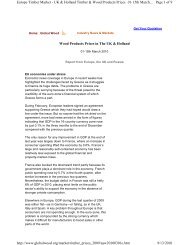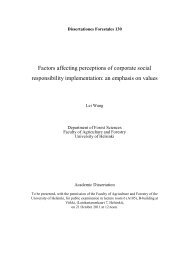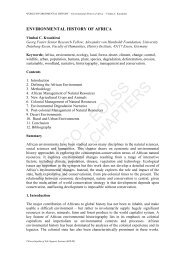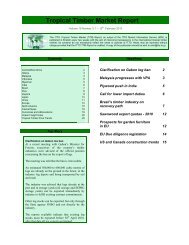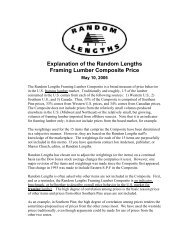ICT and e-Business in the Pulp, Paper and Paper ... - empirica
ICT and e-Business in the Pulp, Paper and Paper ... - empirica
ICT and e-Business in the Pulp, Paper and Paper ... - empirica
You also want an ePaper? Increase the reach of your titles
YUMPU automatically turns print PDFs into web optimized ePapers that Google loves.
<strong>Pulp</strong>, paper <strong>and</strong> paper products<br />
The overall trend appears to be that more services will be outsourced <strong>in</strong> <strong>the</strong> future.<br />
Asked whe<strong>the</strong>r outsourc<strong>in</strong>g would <strong>in</strong>crease, decrease or rema<strong>in</strong> <strong>the</strong> same <strong>in</strong> 2006/07<br />
(compared to 2005), about 30% of companies from <strong>the</strong> P&P <strong>in</strong>dustry anticipated an<br />
<strong>in</strong>crease, <strong>and</strong> only very few companies (5%) said that outsourc<strong>in</strong>g would ra<strong>the</strong>r decrease.<br />
Exhibit 3-5: Outsourc<strong>in</strong>g trend: percentage of companies that have <strong>in</strong>creased / decreased<br />
<strong>the</strong>ir outsourc<strong>in</strong>g activities <strong>in</strong> 2005<br />
-10 -5 0 5 10 15 20 25 30<br />
<strong>Pulp</strong> & <strong>Paper</strong> (EU-10)<br />
-5<br />
29<br />
All 10 sectors (EU-10)<br />
-3<br />
26<br />
Outsourc<strong>in</strong>g has decreased<br />
Outsourc<strong>in</strong>g has <strong>in</strong>creased<br />
Base (100%): Companies that have outsourced <strong>ICT</strong> services. N (for sector, EU-10) = 145.<br />
Weight<strong>in</strong>g: <strong>in</strong> % of firms. Questionnaire reference: B7<br />
Source: e-<strong>Bus<strong>in</strong>ess</strong> W@tch (Survey 2006)<br />
<strong>ICT</strong> expenditure <strong>and</strong> <strong>in</strong>vestments<br />
The average <strong>ICT</strong> budget of a company <strong>in</strong> <strong>the</strong> P&P <strong>in</strong>dustry, <strong>in</strong>clud<strong>in</strong>g hardware,<br />
software, services <strong>and</strong> personnel, corresponds to about 5% of total company costs (see<br />
Exhibit 3-4 above). Close to 20% of all firms <strong>in</strong> <strong>the</strong> P&P <strong>in</strong>dustry plan to fur<strong>the</strong>r <strong>in</strong>crease<br />
<strong>the</strong>ir <strong>ICT</strong> budgets <strong>in</strong> 2006/07, compared to <strong>the</strong> current budget. About 10% say that <strong>the</strong>y<br />
will cut down on <strong>the</strong>ir budgets (see Exhibit 3-7). A majority of about 70% say that <strong>the</strong>y will<br />
ma<strong>in</strong>ta<strong>in</strong> <strong>the</strong>ir current level of spend<strong>in</strong>g.<br />
Large firms <strong>in</strong> <strong>the</strong> sector appear to be significantly more <strong>in</strong>cl<strong>in</strong>ed to cut down on <strong>the</strong>ir<br />
<strong>ICT</strong> budgets than smaller firms. Close to 20% of <strong>the</strong> large companies said that <strong>the</strong>y<br />
would decrease budgets; this is twice as much as on average <strong>in</strong> <strong>the</strong> 10 sectors studied<br />
this year by e-<strong>Bus<strong>in</strong>ess</strong> W@tch – <strong>in</strong> total, about 10% of <strong>the</strong> large firms plan budget cuts.<br />
Moreover, <strong>the</strong> share of large companies with an expansive <strong>ICT</strong> strategy (at least <strong>in</strong> terms<br />
of budgets) is also lower than on average.<br />
Although results should not be over-emphasised, s<strong>in</strong>ce <strong>the</strong> number of cases on which<br />
this observation is based is ra<strong>the</strong>r low (N = 66), it is still significant as a probable trend.<br />
There is no easy explanation why large players from <strong>the</strong> P&P <strong>in</strong>dustry appear to act<br />
aga<strong>in</strong>st <strong>the</strong> overall trend. On <strong>the</strong> contrary, new developments, e.g. <strong>in</strong> RFID technology<br />
<strong>and</strong> e-market<strong>in</strong>g, <strong>and</strong> <strong>the</strong> <strong>in</strong>creas<strong>in</strong>g use of <strong>ICT</strong> for quality assurance <strong>and</strong> <strong>in</strong> production<br />
processes (see case studies <strong>in</strong> this report) could ra<strong>the</strong>r signal dem<strong>and</strong> for <strong>in</strong>vestments<br />
<strong>and</strong> extended budgets. On <strong>the</strong> o<strong>the</strong>r h<strong>and</strong>, some <strong>in</strong>vestments <strong>in</strong> e-bus<strong>in</strong>ess technologies<br />
have reached a mature status <strong>in</strong> large firms (e.g. ERP implementation <strong>and</strong> system<br />
<strong>in</strong>tegration) <strong>and</strong> this may lead to reduced budgetary requirements. Ano<strong>the</strong>r possible<br />
reason is that <strong>ICT</strong> services are <strong>in</strong>creas<strong>in</strong>gly concentrated <strong>in</strong> headquarters, which enables<br />
large companies to reduce costs.<br />
39



